Ophthalmology
Ophthalmology (/ˌɒfθælˈmɒlədʒi/)[1] is a branch of medicine and surgery which deals with the diagnosis and treatment of eye disorders.[2] An ophthalmologist is a specialist in ophthalmology. The credentials include a degree in medicine, followed by additional four to five years of ophthalmology residency training. Ophthalmology residency training programs may require a one-year pre-residency training in internal medicine, pediatrics, or general surgery. Additional specialty training (or fellowship) may be sought in a particular aspect of eye pathology.[3] Ophthalmologists are allowed to use medications to treat eye diseases, implement laser therapy, and perform surgery when needed.[4] Ophthalmologists may participate in academic research on the diagnosis and treatment for eye disorders.[5]
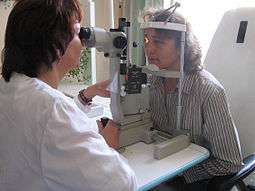 Eye examination with the aid of a slit lamp | |
| System | Eye |
|---|---|
| Significant diseases | Blurred vision, cataract, macular degeneration, glaucoma, diabetic retinopathy, refractive error |
| Significant tests | Visual field test, ophthalmoscopy |
| Specialist | Ophthalmologist |
| Glossary | Glossary of medicine |
Diseases
A partial list of the most common diseases diagnosed and treated by Ophthalmologists include:[6]
- Cataract
- Glaucoma
- Macular degeneration
- Diabetic retinopathy
- Dry eyes
- Strabismus (misalignment/deviation of eyes)
- Proptosis (bulged eyes)
- Excessive tearing (tear duct obstruction)
- Uveitis
- Eye tumors
Diagnosis
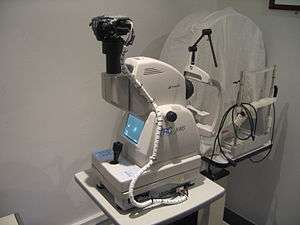
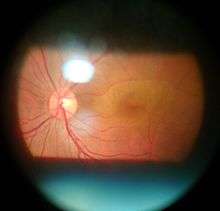
Eye examination
Following are examples of methods of diagnosis performed in an eye examination
- Visual acuity
- Refraction
- Ocular tonometry to determine intraocular pressure
- Slit lamp examination
- Retina examination
Specialized tests
Optical coherence tomography (OCT) is a medical technological platform used to assess ocular structures. The information is then utilized by physicians/doctors to assess staging of pathological processes and confirm clinical diagnoses. Subsequent OCT scans are used to assess the efficacy managing diabetic retinopathy, age-related macular degeneration and glaucoma.
Ultrasonography of the eyes may be performed.
Ophthalmic surgery
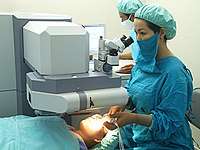
Eye surgery, also known as ocular surgery, is surgery performed on the eye or its adnexa by an ophthalmologist. The eye is a fragile organ, and requires extreme care before, during, and after a surgical procedure. An eye surgeon is responsible for selecting the appropriate surgical procedure for the patient, and for taking the necessary safety precautions.
Subspecialties
Ophthalmology includes subspecialities which deal either with certain diseases or diseases of certain parts of the eye. Some of them are:[7]
- Anterior segment surgery
- Cornea, ocular surface, and external disease
- Glaucoma
- Medical retina, deals with treatment of retinal problems through non-surgical means.
- Vitreo-retinal surgery, deals with surgical management of retinal and posterior segment diseases. Medical retina and vitreo-retinal surgery sometimes together are called posterior segment subspecialisation.
- Neuro-ophthalmology
- Ocular oncology
- Oculoplastics and orbit surgery
- Ophthalmic pathology
- Paediatric ophthalmology/strabismus (misalignment of the eyes)
- Refractive surgery
- Uveitis
- Veterinary specialty training programs in veterinary ophthalmology exist in some countries.[8][9]
Etymology
The Greek roots of the word ophthalmology are ὀφθαλμός (ophthalmos, "eye") and -λoγία (-logia, "study, discourse"),[10][11] i.e., "the study of eyes". The discipline applies to all animal eyes, whether human or not, since the practice and procedures are quite similar with respect to disease processes, while differences in anatomy or disease prevalence, whether subtle or substantial, may differentiate the two.
History
Ancient near east and the Greek period
In the Ebers Papyrus from ancient Egypt dating to 1550 BC, a section is devoted to eye diseases.[2]
The pre-Hippocratics largely based their anatomical conceptions of the eye on speculation, rather than empiricism.[2] They recognized the sclera and transparent cornea running flushly as the outer coating of the eye, with an inner layer with pupil, and a fluid at the centre. It was believed, by Alcamaeon (5th century BC) and others, that this fluid was the medium of vision and flowed from the eye to the brain by a tube. Aristotle advanced such ideas with empiricism. He dissected the eyes of animals, and discovering three layers (not two), found that the fluid was of a constant consistency with the lens forming (or congealing) after death, and the surrounding layers were seen to be juxtaposed. He and his contemporaries further put forth the existence of three tubes leading from the eye, not one. One tube from each eye met within the skull.
The Greek physician Rufus of Ephesus (1st century AD) recognised a more modern eye, with conjunctiva, extending as a fourth epithelial layer over the eye.[2] Rufus was the first to recognise a two-chambered eye, with one chamber from cornea to lens (filled with water), the other from lens to retina (filled with an egg white-like substance).
Celsus the Greek philosopher of the 2nd century AD gave a detailed description of cataract surgery by the couching method.
The Greek physician Galen (2nd century AD) remedied some mistakes including the curvature of the cornea and lens, the nature of the optic nerve, and the existence of a posterior chamber. Though this model was a roughly correct modern model of the eye, it contained errors. Still, it was not advanced upon again until after Vesalius. A ciliary body was then discovered and the sclera, retina, choroid, and cornea were seen to meet at the same point. The two chambers were seen to hold the same fluid, as well as the lens being attached to the choroid. Galen continued the notion of a central canal, but he dissected the optic nerve and saw that it was solid. He mistakenly counted seven optical muscles, one too many. He also knew of the tear ducts.
Ancient India
The Indian surgeon Sushruta wrote Sushruta Samhita in Sanskrit in about 6th century CE[12] which describes 76 ocular diseases (of these 51 surgical) as well as several ophthalmological surgical instruments and techniques.[13][14] His description of cataract surgery was compatible with the method of couching.[15] He has been described as one of the first cataract surgeons.[16][17]
Medieval Islam
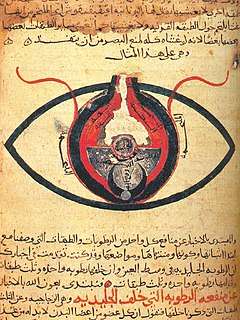
Medieval Islamic Arabic and Persian scientists (unlike their classical predecessors) considered it normal to combine theory and practice, including the crafting of precise instruments, and therefore found it natural to combine the study of the eye with the practical application of that knowledge.[18] Hunayn ibn Ishaq, and others beginning with the medieval Arabic period, taught that the crystalline lens is in the exact center of the eye.[19] This idea was propagated until the end of the 1500s.[19]
Ibn al-Haytham (Alhazen), in his Book of Optics explained that vision occurs when light bounces on an object and then is directed to one's eyes.
Ibn al-Nafis, an Arabic native of Damascus, wrote a large textbook, The Polished Book on Experimental Ophthalmology, divided into two parts, On the Theory of Ophthalmology and Simple and Compounded Ophthalmic Drugs.[20]
Avicenna wrote in his Canon "rescheth" which means "retiformis" and Gerard of Cremona translated this around 1150 into the new word "retina".[21]
Modern Period
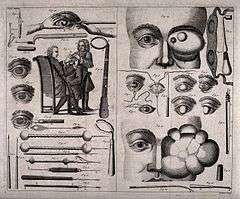
In the 17th and 18th centuries, hand lenses were used by Malpighi, and microscopes by Leeuwenhoek, preparations for fixing the eye for study by Ruysch, and later the freezing of the eye by Petit. This allowed for detailed study of the eye and an advanced model. Some mistakes persisted, such as: why the pupil changed size (seen to be vessels of the iris filling with blood), the existence of the posterior chamber, and the nature of the retina. Unaware of their functions, Leeuwenhoek noted the existence of photoreceptors,[22] however, they were not properly discovered until Gottfried Reinhold Treviranus in 1834.
Around 1750, Jacques Daviel advocated a new treatment for cataract by extraction instead of the traditional method of couching.[23] Georg Joseph Beer (1763–1821) was an Austrian ophthalmologist and leader of the First Viennese School of Medicine. He introduced a flap operation for treatment of cataract (Beer's operation), as well as popularizing the instrument used to perform the surgery (Beer's knife).[24]
In North America, indigenous healers treated some eye diseases by rubbing or scraping the eyes or eyelids.[25]
Ophthalmic surgery in Great Britain
The first ophthalmic surgeon in Great Britain was John Freke, appointed to the position by the Governors of St Bartholomew's Hospital in 1727. A major breakthrough came with the appointment of Baron de Wenzel (1724–90), a German who became oculist to King George III of England in 1772. His skill at removing cataract legitimized the field.[23] The first dedicated ophthalmic hospital opened in 1805 in London; it is now called Moorfields Eye Hospital. Clinical developments at Moorfields and the founding of the Institute of Ophthalmology (now part of the University College London) by Sir Stewart Duke-Elder established the site as the largest eye hospital in the world and a nexus for ophthalmic research.[26]
19th and 20th centuries
_pg479_NEW-YORK_OPHTHALNIC_HOSPITAL%2C_THIRD_AVENUE_AND_EAST_23D_STREET.jpg)
The prominent opticians of the late 19th and early 20th centuries included Ernst Abbe (1840–1905), a co-owner of at the Zeiss Jena factories in Germany where he developed numerous optical instruments. Hermann von Helmholtz (1821-1894) was a polymath who made contributions to many fields of science and invented the ophthalmoscope in 1851. They both made theoretical calculations on image formation in optical systems and had also studied the optics of the eye. In Berlin, Albrecht von Graefe introduced iridectomy as a treatment for glaucoma and improved cataract surgery, he is also considered the founding father of the German Ophthalmological Society.
Central Europe
Numerous ophthalmologists fled Germany after 1933 as the Nazis began to persecute those of Jewish descent. A representative leader was Joseph Igersheimer (1879–1965), best known for his discoveries with arsphenamine for the treatment of syphilis. He fled to Turkey in 1933. As one of eight emigrant directors in the Faculty of Medicine at the University of Istanbul, he built a modern clinic and trained students. In 1939, he went to the United States, becoming a professor at Tufts University.[27] German ophthalmologist, Gerhard Meyer-Schwickerath is widely credited with developing the predecessor of laser coagulation, photocoagulation. In 1946, he conducted the first experiments on light coagulation. In 1949, he performed the first successful treatment of a retinal detachment with a light beam (light coagulation) by with a self-constructed device on the roof of the ophthalmic clinic at the University of Hamburg-Eppendorf.[28][29]
Polish ophthalmology dates to the 13th century. The Polish Ophthalmological Society was founded in 1911. A representative leader was Adam Zamenhof (1888–1940), who introduced certain diagnostic, surgical, and nonsurgical eye-care procedures and was shot by the German Nazis in 1940.[30] Zofia Falkowska (1915–93) head of the Faculty and Clinic of Ophthalmology in Warsaw from 1963 to 1976, was the first to use lasers in her practice.
Professional requirements
Ophthalmologists are physicians (MD/DO in the US or MBBS in the UK and elsewhere or D.O./DOMS/ DNB, not OD or BOptom) who have completed a college degree, medical school, and residency in ophthalmology. Ophthalmology training equips eye specialists to provide the full spectrum of eye care, including the prescription of glasses and contact lenses, medical treatment, and complex microsurgery. In many countries, ophthalmologists also undergo additional specialized training in one of the many subspecialties. Ophthalmology was the first branch of medicine to offer board certification, now a standard practice among all specialties.
Australia and New Zealand
In Australia and New Zealand, the FRACO/FRANZCO is the equivalent postgraduate specialist qualification. The structured training system takes place over five years of postgraduate training. Overseas-trained ophthalmologists are assessed using the pathway published on the RANZCO website. Those who have completed their formal training in the UK and have the CCST/CCT are usually deemed to be comparable.
Bangladesh
In Bangladesh to be an ophthalmologist the basic degree is an MBBS. Then they have to obtain a postgraduate degree or diploma in specialty ophthalmology. In Bangladesh, these are Diploma in Ophthalmology, Diploma in Community Ophthalmology, Fellow or Member of the College of Physicians and Surgeons in ophthalmology, and Master of Science in ophthalmology.
Canada
In Canada, an ophthalmology residency after medical school is undertaken. The residency lasts a minimum of five years after the MD degree which culminates in fellowship of the Royal College of Surgeons of Canada (FRCSC). Subspecialty training is undertaken by about 30% of fellows (FRCSC) in a variety of fields from anterior segment, cornea, glaucoma, vision rehabilitation, uveitis, oculoplastics, medical and surgical retina, ocular oncology, Ocular pathology, or neuro-ophthalmology. About 35 vacancies open per year for ophthalmology residency training in all of Canada. These numbers fluctuate per year, ranging from 30 to 37 spots. Of these, up to ten spots are at French-speaking universities in Quebec. At the end of the five years, the graduating ophthalmologist must pass the oral and written portions of the Royal College exam in either English or French.
Finland
In Finland, physicians willing to become ophthalmologists must undergo a five-year specialization which includes practical training and theoretical studies.
India
In India, after completing MBBS degree, postgraduate study in ophthalmology is required. The degrees are Doctor of Medicine, Master of Surgery, Diploma in Ophthalmic Medicine and Surgery, and Diplomate of National Board. The concurrent training and work experience are in the form of a junior residency at a medical college, eye hospital, or institution under the supervision of experienced faculty. Further work experience in form of fellowship, registrar, or senior resident refines the skills of these eye surgeons. All India Ophthalmologist Society and various state-level ophthalmologist societies hold regular conferences and actively promote continuing medical education.
Nepal
In Nepal, to become an ophthalmologist, three years postgraduate study is required after completing MBBS degree. The postgraduate degree in ophthalmology is called MD in Ophthalmology. This degree is currently provided by Tilganga Institute of Ophthalmology, Tilganga, Kathmandu, BPKLCO, Institute of Medicine, TU, Kathmandu, BP Koirala Institute of Health Sciences, Dharan, Kathmandu University, Dhulikhel and National Academy of Medical Science, Kathmandu. Few Nepalese citizen also study this subject in Bangladesh, China, India, Pakistan and other countries. All the graduates have to pass Nepal Medical Council Licensing Exam to become a registered Ophthalmologist in Nepal. The concurrent residency training is in the form of a PG student (resident) at a medical college, eye hospital, or institution according to the degree providing university's rules and regulations. Nepal Ophthalmic Society holds regular conferences and actively promote continuing medical education.
Ireland
In Ireland, the Royal College of Surgeons of Ireland grants Membership (MRCSI (Ophth)) and Fellowship (FRCSI (Ophth)) qualifications in conjunction with the Irish College of Ophthalmologists. Total postgraduate training involves an intern year, a minimum of three years of basic surgical training and a further 4.5 years of higher surgical training. Clinical training takes place within public, Health Service Executive-funded hospitals in Dublin, Sligo, Limerick, Galway, Waterford, and Cork. A minimum of 8.5 years of training is required before eligibility to work in consultant posts. Some trainees take extra time to obtain MSc, MD or PhD degrees and to undertake clinical fellowships in the UK, Australia and the United States.
Pakistan
In Pakistan, after MBBS, a four-year full-time residency program leads to an exit-level FCPS examination in ophthalmology, held under the auspices of the College of Physicians and Surgeons, Pakistan. The tough examination is assessed by both highly qualified Pakistani and eminent international ophthalmic consultants. As a prerequisite to the final examinations, an intermediate module, an optics and refraction module, and a dissertation written on a research project carried out under supervision is also assessed. Moreover, a two-and-a-half-year residency program leads to an MCPS while a two-year training of DOMS is also being offered.[31] For candidates in the military, a stringent two-year graded course, with quarterly assessments, is held under Armed Forces Post Graduate Medical Institute in Rawalpindi. The M.S. in ophthalmology is also one of the specialty programs. In addition to programs for doctors, various diplomas and degrees for allied eyecare personnel are also being offered to produce competent optometrists, orthoptists, ophthalmic nurses, ophthalmic technologists, and ophthalmic technicians in this field. These programs are being offered notably by the College of Ophthalmology and Allied Vision Sciences in Lahore and the Pakistan Institute of Community Ophthalmology in Peshawar.[32] Subspecialty fellowships are also being offered in the fields of pediatric ophthalmology and vitreoretinal ophthalmology. King Edward Medical University, Al Shifa Trust Eye Hospital Rawalpindi, and Al- Ibrahim Eye Hospital Karachi have also started a degree program in this field.
Philippines
Ophthalmology is a considered a medical specialty that uses medicine and surgery to treat diseases of the eye. There is only one, duly recognized by the PMA and the PCS, professional organization in the country: the Philippine Academy of Ophthalmology (PAO).[33] PAO and the state-standard Philippine Board of Ophthalmology (PBO) regulates ophthalmology residency programs and board certification. To become a general ophthalmologist in the Philippines, a candidate must have completed a Doctor of Medicine degree (MD) or its equivalent (e.g. MBBS), have completed an internship in Medicine, have passed the physician licensure exam, and completed residency training at a hospital accredited by the Philippine Board of Ophthalmology (accrediting arm of PAO).[34] Attainment of board certification in ophthalmology from the PBO is essential in acquiring privileges in most major health institutions. Graduates of residency programs can receive further training in ophthalmology subspecialties, such as neuro-ophthalmology, retina, etc. by completing a fellowship program which varies in length depending on each program's requirements.
United Kingdom
In the United Kingdom, three colleges grant postgraduate degrees in ophthalmology. The Royal College of Ophthalmologists (RCOphth) and the Royal College of Surgeons of Edinburgh grant MRCOphth/FRCOphth and MRCSEd/FRCSEd, (although membership is no longer a prerequisite for fellowship), the Royal College of Glasgow grants FRCS. Postgraduate work as a specialist registrar and one of these degrees is required for specialization in eye diseases. Such clinical work is within the NHS, with supplementary private work for some consultants. Only 2.3 ophthalmologists exist per 100,000 population in the UK – fewer pro rata than in any other nation in the European Union.[35]
United States
In the United States, ophthalmologists must complete four years of undergraduate studies, four years of medical school, one year medical or general surgical residency, three years of ophthalmology residency and optional one to two years of speciality training. Ophthalmologists are Doctors of Medicine that specialize in the eye and related structures. They perform medical and surgical eye care and can also write prescriptions for corrective lenses (glasses and contacts). They often deal with advanced forms of eye disease in patients with significant systemic illness.
Physicians must complete the requirements of continuing medical education to maintain licensure and for recertification. Professional bodies like the American Academy of Ophthalmology and American Society of Cataract and Refractive Surgery organize conferences, help physician members through continuing medical education programs for maintaining board certification, and provide political advocacy and peer support.
Notable ophthalmologists
The following is a list of physicians who have significantly contributed to the field of ophthalmology:
18th–19th centuries
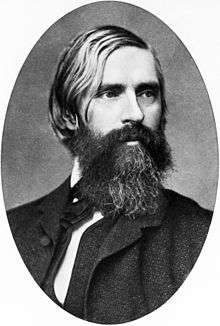
- Theodor Leber discovered Leber's congenital amaurosis, Leber's hereditary optic neuropathy, Leber's miliary aneurysm, and Leber's stellate neuroretinitis.
- Carl Ferdinand von Arlt (1812–1887), the elder (Austrian), proved that myopia is largely due to an excessive axial length, published influential textbooks on eye disease, and ran annual eye clinics in needy areas long before the concept of volunteer eye camps became popular. His name is still attached to some disease signs, e.g., von Arlt's line in trachoma. His son Ferdinand Ritter von Arlt, the younger, was also an ophthalmologist.
- Jacques Daviel (France) claimed to be the founder of modern cataract surgery in that he performed cataract extraction instead of needling the cataract or pushing it back into the vitreous. He is said to have carried out the technique on 206 patients in 1752–53, of which 182 were reported to be successful. These figures are not very credible, given the total lack of both anaesthesia and aseptic technique at that time.
- Franciscus Donders (1818–1889) (Dutch) published pioneering analyses of ocular biomechanics, intraocular pressure, glaucoma, and physiological optics. He made possible the prescribing of combinations of spherical and cylindrical lenses to treat astigmatism.
- Joseph Forlenze (1757–1833) (Italy), specialist in cataract surgery, became popular during the First French Empire, healing, among many, personalities such as the minister Jean-Étienne-Marie Portalis and the poet Ponce Denis Lebrun. He was nominated by Napoleon "chirurgien oculiste of the lycees, the civil hospices and all the charitable institutions of the departments of the Empire".[36] He was known also for his free interventions, mainly in favour of poor people.
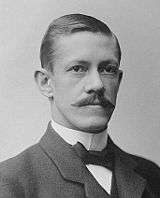
- Albrecht von Graefe (1828–1870) (Germany) Along with Helmholtz and Donders, one of the 'founding fathers' of ophthalmology as a specialty. He was a brilliant clinician and charismatic teacher who had an international influence on the development of ophthalmology, and was a pioneer in mapping visual field defects and diagnosis and treatment of glaucoma. He introduced a cataract extraction technique that remained the standard for over 100 years, and many other important surgical techniques such as iridectomy. He rationalised the use of many ophthalmically important drugs, including mydriatics and miotics. He also was the founder of one of the earliest ophthalmic societies (German Ophthalmological Society, 1857) and one of the earliest ophthalmic journals (Graefe's Archives of Ophthalmology). He was probably the most important ophthalmologist of the 19th century.
- Allvar Gullstrand (Sweden) was a Nobel Prize-winner in 1911 for his research on the eye as a light-refracting apparatus. He described the 'schematic eye', a mathematical model of the human eye based on his measurements known as the 'optical constants' of the eye. His measurements are still used today.
- Hermann von Helmholtz, a great German polymath, invented the ophthalmoscope (1851) and published important work on physiological optics, including colour vision (1850s).
- José Rizal (Philippines) was a polymath who inspired the Philippine Revolution with his writings.
- Julius Hirschberg (Germany) in 1879 became the first to use an electromagnet to remove metallic foreign bodies from the eye and in 1886 developed the Hirschberg test for measuring strabismus.
- Peter Adolph Gad (1846 – 1907), Danish ophthalmologist who founded the first eye infirmary in São Paulo, Brazil.
- Socrate Polara (1800–1860, Italy) founded the first dedicated ophthalmology clinic in Sicily in 1829, entirely as a philanthropic endeavor; later he was appointed as the first director of the ophthalmology department at the Grand Hospital of Palermo, Sicily, in 1831 after the Sicilian government became convinced of the importance of state support for the specialization.[37]
- Herman Snellen (Netherlands) introduced the Snellen chart to study visual acuity.
20th–21st centuries
- Vladimir Petrovich Filatov (1875–1956) (Ukraine) contributed the tube flap grafting method, corneal transplantation, and preservation of grafts from cadaver eyes and tissue therapy. He founded the Filatov Institute of Eye Diseases and Tissue Therapy, Odessa, one of the leading eye-care institutes in the world.
- Shinobu Ishihara (1879-1963) (Japan), in 1918, invented to Ishihara Color Vision Test, a common method for determining Color blindness. He also made major contributions to the study of Trachoma and Myopia.
- Ignacio Barraquer (1884–1965) (Spain), in 1917, invented the first motorized vacuum instrument (erisophake) for intracapsular cataract extraction. He founded the Barraquer Clinic in 1941 and the Barraquer Institute in 1947 in Barcelona, Spain.
- Ernst Fuchs (1851-1930) was an Austrian ophthalmologist known for his discovery and description of numerous ocular diseases and abnormalities including Fuchs' dystrophy and Fuchs heterochromic iridocyclitis.[38]
- Tsutomu Sato (Japan) Pioneer in incisional refractive surgery, including techniques for astigmatism and the invention of radial keratotomy for myopia.
- Jules Gonin (1870–1935) (Switzerland) was the "father of retinal detachment surgery".
- Sir Harold Ridley (United Kingdom), in 1949, may have been the first to successfully implant an artificial intraocular lens after observing that plastic fragments in the eyes of wartime pilots were well tolerated. He fought for decades against strong reactionary opinions to have the concept accepted as feasible and useful.
- Charles Schepens (Belgium) was the "father of modern retinal surgery" and developer of the Schepens indirect binocular ophthalmoscope whilst at Moorfields Eye Hospital. He was the founder of the Schepens Eye Research Institute, associated with Harvard Medical School and the Massachusetts Eye and Ear Infirmary, in Boston, Massachusetts.
- Marshall M. Parks was the "father of pediatric ophthalmology".
- José Ignacio Barraquer (1916–1998) (Spain) was the "father of modern refractive surgery". In the 1960s, he developed lamellar techniques, including keratomileusis and keratophakia, as well as the first microkeratome and corneal microlathe.
- Frank M Polack (1929 – 2007) was an American ophthalmologist who designed the Polack forceps for corneal transplants.
- Frederick T. Fraunfelder (b. 1934), ocular oncologist
- Tadeusz Krwawicz (Poland), in 1961, developed the first cryoprobe for intracapsular cataract extraction.
- Svyatoslav Fyodorov (Russia) was the "father of ophthalmic microsurgery". He improved and popularized radial keratotomy, invented a surgical cure for cataract, and developed scleroplasty.
- Charles Kelman (United States) developed the ultrasound and mechanized irrigation and aspiration system for phacoemulsification, first allowing cataract extraction through a small incision.
- Ioannis Pallikaris (Greece) performed the first laser-assisted intrastromal keratomileusis (LASIK) surgery.
See also
References
- "ophthalmology". Oxford Dictionary. Retrieved 14 September 2015.
- "History of Ophthalmology". www.mrcophth.com.
- Boyd, Kierstan (6 June 2016). "Ophthalmology Subspecialists". American Academy of Ophthalmology.
- Smith, Yolanda (5 September 2016). "Ophthalmology". News-Medical.net.
- Churchill, Jennifer; Gudgel, Dan T. (1 November 2013). "What is an Ophthalmologist?". American Academy of Ophthalmology.
- WebMD. "What Causes Eye Problems?". WebMD.
- Smith, Yolanda (2017-01-17). "Subspecialties of Ophthalmology". News Medical Life Sciences.
- "Acvo.com". Acvo.com. Retrieved 2012-05-27.
- "Ecvo.org". Ecvo.org. Retrieved 2012-05-27.
- "ophthalmology". Online Etymology Dictionary.
- ὀφθαλμός. Liddell, Henry George; Scott, Robert; A Greek–English Lexicon at the Perseus Project
- Boslaugh, Sarah (2007). Encyclopedia of epidemiology. SAGE. p. 547. ISBN 978-1412928168.
- Bidyadhar, N.K. (1939), Sushruta's Ophthalmic Operations, Archives of Ophthalmology, 22, page 553.
- Agarwal, R.K. (1965), Ancient Indian Ophthalmology, The Ophthalmic Optician, 5(21),1093-1100 (the title of this journal was changed to Optometry Today in 1985), published by the Association of Optometrists, London, England.
- Roy, P.N., Mehra, K.S. and Deshpande, P.J. (1975), Cataract surgery performed before 800 BC, British Journal of Ophthalmology, 59, page 171
- "Susruta: The Great Surgeon of Yore". Infinityfoundation.com. Retrieved 2008-11-04.
- Kansupada, K. B.; Sassani, J. W. (1997). "Sushruta: The father of Indian surgery and ophthalmology". Documenta Ophthalmologica. Advances in Ophthalmology. 93 (1–2): 159–167. doi:10.1007/BF02569056. PMID 9476614.
- David C. Lindberg (1980). Science in the Middle Ages. University of Chicago Press. p. 21. ISBN 0-226-48233-2.
- Leffler CT, Hadi TM, Udupa A, Schwartz SG, Schwartz D (2016). "A medieval fallacy: the crystalline lens in the center of the eye". Clinical Ophthalmology. 2016 (10): 649–662. doi:10.2147/OPTH.S100708. PMC 4833360. PMID 27114699.
- David C. Lindberg (1997). Helaine Selin (ed.). Encyclopaedia of the History of Science, Technology, and Medicine in Non-Western Cultures. Kluwer Academic Publishers. p. 410. ISBN 0792340663.
- de Jong, Paulus T. V. M. (10 August 2014). "From where does "rete" in retina originate?". Graefe's Archive for Clinical and Experimental Ophthalmology. 252 (10): 1525–1527. doi:10.1007/s00417-014-2769-1. PMID 25107541.
- "Important Dates in Vision Science". www.arts.rpi.edu.
- Wyman A.L. (1991). "Baron De Wenzel, Oculist to King George III: His Impact on British Ophthalmologists". Medical History. 35 (1): 78–88. doi:10.1017/s0025727300053138. PMC 1036270. PMID 2008123.
- Fuchs, Ernst (2001-01-01). Fuchs, Ernst, and Alexander Duane.Text-book of Ophthalmology. Philadelphia, PA: J.B. Lippincott Company, 1908. Retrieved 2013-03-11.
- Leffler CT, et al. (2017). "Ophthalmology in North America: Early Stories (1491-1801)". Ophthalmology and Eye Diseases. 9: 1–51. doi:10.1177/1179172117721902. PMC 5533269. PMID 28804247.
- Davidson Luke (1996). "'Identities Ascertained': British Ophthalmology in the First Half of the Nineteenth Century". Social History of Medicine. 9 (3): 313–333. doi:10.1093/shm/9.3.313. PMID 11618725.
- Namal Arin, Reisman Arnold (2007). "Joseph Igersheimer (1879–1965): A Visionary Ophthalmologist and his Contributions before and after Exile". Journal of Medical Biography. 15 (4): 227–234. doi:10.1258/j.jmb.2007.06-63. PMID 18172563.
- Goes, Frank (2013). Eye in history. New Delhi: Jaypee Brothers. ISBN 9789350902745. OCLC 813930522.
- Boyd, Benjamin (2010). Modern ophthalmology : the highlights : the account of a master wintnessing a 60 year epoch of evolution and progress (1950-2010). Panama: Jaypee-Highlights Medical Publishers. ISBN 9789962678168. OCLC 720191230.
- Wincewicz Andrzej; et al. (2009). "Dr Adam Zamenhof (1888-1940) and his insight into ophthalmology". Journal of Medical Biography. 17 (1): 18–22. doi:10.1258/jmb.2008.008037. PMID 19190194.
- "College of Physicians and Surgeons Pakistan". Cpsp.edu.pk. Retrieved 2012-05-27.
- "King Edward Medical University". Kemu.edu.pk. Archived from the original on 2015-07-08. Retrieved 2012-05-27.
- "Philippine Academy of Ophthalmology". PAO.org.ph. Retrieved 2012-05-27.
- "PBO Officers". PAO.org.ph. 2012-12-01. Archived from the original on 2013-03-02. Retrieved 2013-03-11.
- "European Union of medical specialists". Uems.net. Retrieved 2013-03-11.
- Jan Ellen Goldstein, Console and Classify. The French Psychiatric Profession in the Nineteenth Century, Chicago Press, 2002, p. 63
- Parisi, Antonino (1838). Annuario Storico del Regno della Due Sicilie, dal Principio del Governo, di Ferdinando II Borbone. Tipografica Trani (Napoli). pp. 66–67.
- Müller, Andreas (1 June 2003). "Professor Ernst Fuchs (1851-1930)". Archives of Ophthalmology. 121 (6): 888–91. doi:10.1001/archopht.121.6.888. PMID 12796263.
External links
| Wikimedia Commons has media related to Ophthalmology. |